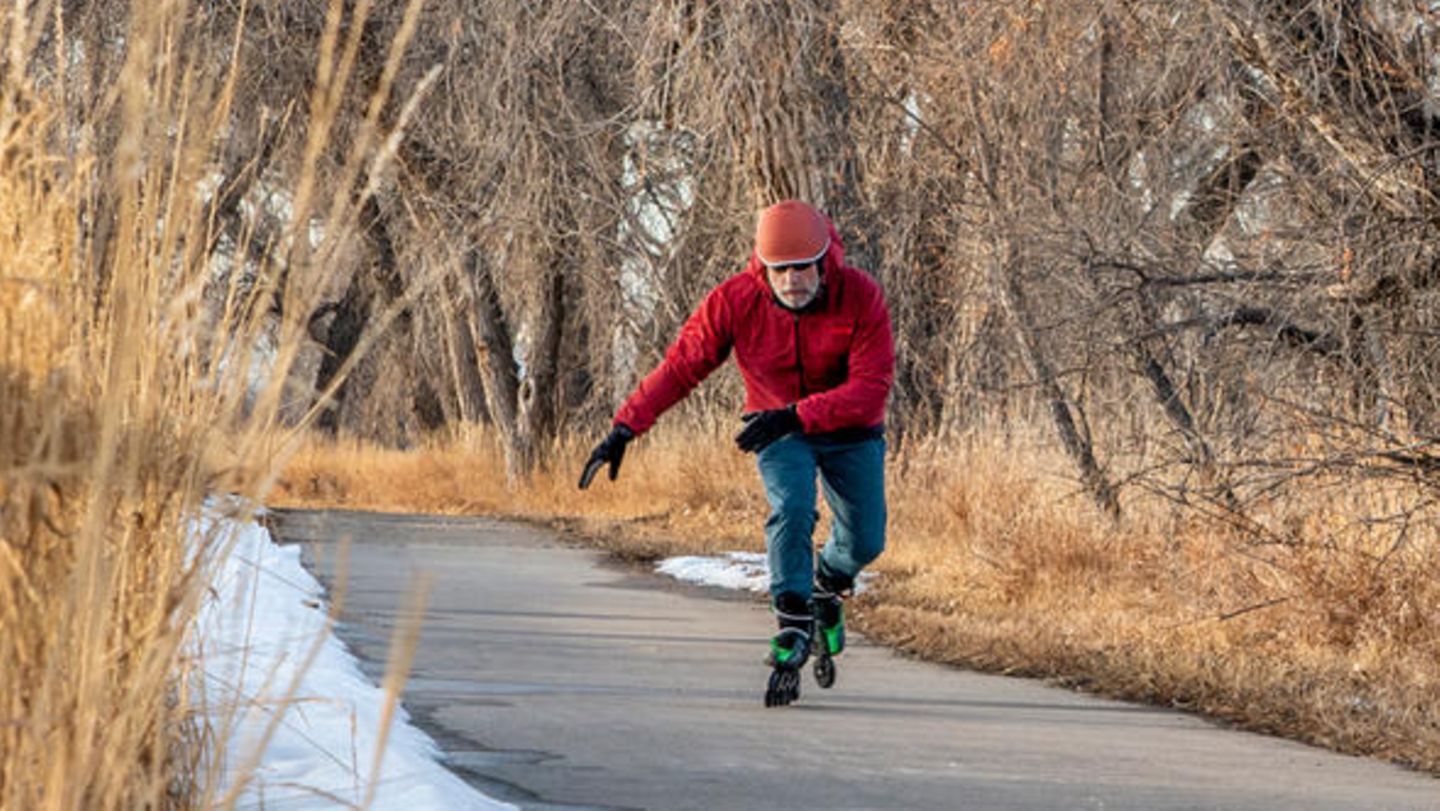Whether old or young: inline skates are all the rage. Driving on four wheels is not only fun, it also promotes physical fitness. In Germany alone, almost a million people participate in this popular sport on a regular basis – and the trend is rising.
Roller skates, which were patented as early as 1863, are pioneers of inline skates. The difference lies essentially in the arrangement of the wheels: while under the classic roller skates there are two wheels next to each other, with the inline skates they are arranged one behind the other (i.e. lengthways, hence the name derived from the English “in-line”). Due to the increasing interest in the trend sport, there are now many different models, for example inline skates with soft or hard shoes, large or small wheels. This article summarizes what the different variants mean, which accessories are important for novice drivers and how you can learn to skate in no time at all.
This is where inline skates differ
There is now a large selection of inline skates from well-known manufacturers such as , , and which differ from each other as follows:
- Hardboot-Skates: Translated, the term “hardboot” simply means: hard shoes. Corresponding models with a high shaft offer the feet a particularly firm hold, which is why they are preferably used for inline hockey, street or speed skating (with a low shaft). The outer shell is usually made of hard plastic, while the inner shoe is softly padded.
- Softboot-Skates: In contrast to hard boot skates, the soft boot version is significantly softer – and therefore more comfortable. So that the feet still have a firm fit in the shoes, models with a high shaft are the better choice (for beginners). Another feature of soft boot skates are the brake pads on the heel, which offer beginners more safety while riding, as well as larger wheels.
- Speed-Skates: As the name suggests, speed skates can reach particularly high speeds – which is why they are also used in racing. Typical features include a low shaft height that just reaches the ankles, a lightweight construction and rollers with a larger diameter (90 to 125 millimeters). There are models with four and five rollers.
- Street-Skates: Inline skates also call them aggressive skates: These models are mainly seen in skate parks, on halfpipes and ramps. Due to their special construction (hard shell, light weight, small rollers between 50 and 60 millimeters in diameter) they are particularly suitable for spectacular stunts. Whether slalom or stair riding: Street skates are highly maneuverable.
- Inlinehockey-Skates: As with ice skates, these skates are lace-up shoes that are mounted on an inline rail (instead of a runner as in ice hockey). The models are particularly hard and robust – this applies above all to the toe, which has been specially reinforced. Typical features include the castors: two low ones are mounted at the front, two higher ones at the rear. There is no brake block on these skates.
Another note about the roles: Depending on which inline skates you choose, they can be of different sizes or arranged. It is important for beginners to know that larger reels are more difficult to control than small ones. The degree of hardness should also not be ignored, as hard rollers wear out more slowly than soft ones – but should not be the first choice for beginners as they are less comfortable.
Buying tips: what to look out for
When looking for a new pair of inline skates, it’s not just size that should be considered. Rather, the shaft height, the length of the rails and the size of the rollers are also important. Regardless of whether you have a model for , or want to buy:
- Weight: Heavy inline skates have a significantly cheaper price, but are more difficult to ride. Lighter models, on the other hand, are slightly more expensive, but also more pleasant to drive – the lower weight is particularly noticeable in terms of speed and maneuverability.
- Shoe height: A short shaft height, as is found mainly in speed skates, saves a bit of weight – but it also offers less support for the feet. For this reason, inline skates with a high shaft are more suitable for beginners and beginners.
- Damping: The better the suspension of inline skates, the more comfortable it is to ride – especially on uneven stretches. When buying new roller blades, make sure that they have integrated damping that can cushion small bumps.
- Rail length: In fact, the length of the inline rail also has an impact on the driving experience. The longer it is, the more thrust you have and the faster you can ride it. The only downer is that the models are not as manoeuvrable as those with short rails.
- Roll size: As mentioned before, you can go faster with large rollers than with small ones. In addition, they offer greater comfort on uneven stretches. The disadvantage is that large rollers are less flexible because they require more space, i.e. a longer rail.
Accessories: How to protect yourself properly
If you have never or only rarely skated inline skating, you should protect yourself against possible falls. The best way to do this is to wear hand, knee and elbow pads – these are available from Decathlon as a set for and . The basic equipment should also include a skate helmet that protects your head from dangerous injuries. There are also suitable ones here for big and small skaters, which can be adjusted individually.
Learning to ride inline skates: this is how it works
If possible, you should make your first attempts on a smooth, paved road with no potholes or cracks. For example, in an empty parking lot or on a street with little traffic in an industrial area. In the beginning, avoid roads with a slight incline so that you do not roll off automatically and uncontrollably. It is also advisable to take the first steps with the help of a second person – or you can find a wall that you can climb along. Never underestimate the speed that you will pick up while driving, as long as you are not yet able to brake safely. The following tips are intended to provide you with a little help when riding inline skates:
1. Learn to approach
Place your legs hip-width apart so that you have a secure footing on the inline skates and bend your knees slightly. To set off, you need to put one leg back so that you push yourself off the ground. As soon as you start rolling, you shift your body weight onto the other leg – just like you would in ice skating, if you can do it. To move forward, slip each step forward at a slight angle as you push your feet off the floor. As you slowly get going, you can place your legs next to each other as you roll.
2. Mastering curves
Curves are a challenge, especially for novice drivers. To master these too, you can use different tricks:
- If you want to drive around to the left, shift your weight onto your left foot and push your left leg in front of your right – this will automatically put you in the desired angle. To the right go exactly the other way around.
- Or you can master the turns as you would when skiing by turning your hips to the left or right – depending on whether you want to make a left or right turn. It is important that the hips always point in the direction of travel.
- When you want to turn left, shift your center of gravity to your left foot and push yourself away from the floor with your right foot. Then place it in front of your left foot so that it can then translate in front of your right foot (alternating).
3. Practice braking
If you want to learn to ride inline skates, you should definitely master the art of braking. To do this, either use the stopper on the heel of your shoes by shifting your weight onto your supporting leg (i.e. the stronger leg) and pressing the block onto the floor at the same time. Or you lean on your standing leg and place your other leg on the ground across the direction of travel – this creates a kind of T and comes to a standstill. Alternatively, you can do the “snow plow”, just like skiing, by gathering your feet so that they resemble an upside-down V.
4. Fall right
Falling also needs to be learned: the more purposefully you can fall, the fewer wounds you will suffer. The best way to do this is to use a mattress that you can practice falling down on – by falling knees first, trying to turn so that you land on your side or on your back. This will protect your arms and hands, but also your neck and head, from serious injuries. Should you nevertheless fall on your knees or wrists, the joint protectors cushion the fall.
Regulations: That’s what the ADAC says
According to the ADAC, inline skaters are treated like pedestrians, i.e. they should ride on the sidewalk. That means in plain language: You have to adjust the speed according to your environment. If there are no pedestrian paths, you can skate right or left as close as possible to the edge of the road within a town. Basically, roads and bike paths are forbidden for inline skaters – unless they are cleared by the police during an event (e.g. skate or blade nights).
Since 2009 there has been another exception, which the ADAC describes as follows: “With a new additional symbol, inline skating can exceptionally be permitted on sufficiently wide cycle paths. Anyone who skates there has to be extremely careful and with special consideration for the rest of the traffic right edge to move in the direction of travel and must enable cyclists to overtake. ”
And another important note: Even if there is no statutory helmet or protective equipment requirement for inline skaters in Germany, it is still advisable – especially for beginners – to protect their body with equipment in the event of a fall.
,
This article contains so-called affiliate links. Further information are available here.
I have been working in the news industry for over 6 years, first as a reporter and now as an editor. I have covered politics extensively, and my work has appeared in major newspapers and online news outlets around the world. In addition to my writing, I also contribute regularly to 24 Hours World.




